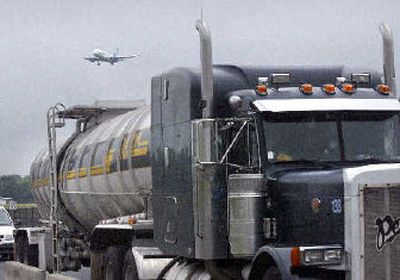On the runway and out of gas?

WASHINGTON — Lost luggage, bad weather and now … no fuel?
While fliers haven’t yet had to add that problem to the list of headaches associated with air travel, it may not be far away. Airports in Arizona, California, Florida and Nevada recently came within a few days — and at times within hours — of running out of jet fuel.
Because of supply bottlenecks, airlines were forced to fly in extra fuel from other markets and scramble for deliveries by truck. But these are expensive, short-term fixes that do not address what airline executives consider to be the underlying problem: with passenger traffic rising above pre-9/11 levels, the nation’s aviation business is slowly outgrowing the infrastructure that fuels it.
What started as routine supply tightness in these markets quickly snowballed following disruptive events that included a hurricane, a canceled fuel shipment and, ironically, the airlines’ own efforts to prevent shortages, according to several airline executives.
Late July and early August were “unprecedented for Southwest for the number of cities where we’ve had to manage supply problems,” said Glenn Hipp, director of fuel purchasing and inventory management at Dallas-based Southwest Airlines Co. AMR Corp.’s American Airlines, UAL Corp.’s United Airlines and America West Holdings Corp., also said there has been recent supply trouble.
These airlines have not canceled flights or made extra stops to tank up, nor have planes flown with less than the minimum fuel required by the Federal Aviation Administration, executives said.
But the near shortages underscore the added strain on refineries, pipelines and the airlines’ own fuel procurement efforts as the industry recovers from its worst-ever downturn — June passenger traffic was up 4 percent from 2001 levels, according to industry data — and energy demand rises throughout the economy.
“It’s really starting to surface as an issue,” said James Holland, vice president of logistics at Kinder Morgan Energy Partners L.P., a Houston-based pipeline operator.
Part of the problem is that refining and pipeline capacity in some regions of the U.S. have grown slower than demand, meaning companies must run their equipment harder to satisfy growing fuel needs. This raises the chances of operational snags and leaves less of a cushion when something does go wrong. Recent refinery outages have helped push oil prices to record heights near $64 a barrel.
Also, the petroleum industry has reduced its fuel inventories in recent decades, redirecting funds once spent on storage to more lucrative oil drilling. Thus, some of the burden of storing surplus fuel has shifted to the airlines. But the industry’s financial woes have hindered its ability, or willingness, to increase spending on storage, according to John Armbrust, publisher of Jet Fuel Report, an industry newsletter.
“If more effort isn’t put into resolving some of these issues, it could have serious impact on the operational integrity of the whole aviation system,” warned Bob Sturtz, general manager of fuel at Elk Grove Village, Ill.-based United Airlines.